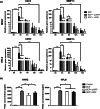Gla-rich protein is involved in the cross-talk between calcification and inflammation in osteoarthritis
- PMID: 26337479
- PMCID: PMC11108449
- DOI: 10.1007/s00018-015-2033-9
Gla-rich protein is involved in the cross-talk between calcification and inflammation in osteoarthritis
Abstract
Osteoarthritis (OA) is a whole-joint disease characterized by articular cartilage loss, tissue inflammation, abnormal bone formation and extracellular matrix (ECM) mineralization. Disease-modifying treatments are not yet available and a better understanding of osteoarthritis pathophysiology should lead to the discovery of more effective treatments. Gla-rich protein (GRP) has been proposed to act as a mineralization inhibitor and was recently shown to be associated with OA in vivo. Here, we further investigated the association of GRP with OA mineralization-inflammation processes. Using a synoviocyte and chondrocyte OA cell system, we showed that GRP expression was up-regulated following cell differentiation throughout ECM calcification, and that inflammatory stimulation with IL-1β results in an increased expression of COX2 and MMP13 and up-regulation of GRP. Importantly, while treatment of articular cells with γ-carboxylated GRP inhibited ECM calcification, treatment with either GRP or GRP-coated basic calcium phosphate (BCP) crystals resulted in the down-regulation of inflammatory cytokines and mediators of inflammation, independently of its γ-carboxylation status. Our results strengthen the calcification inhibitory function of GRP and strongly suggest GRP as a novel anti-inflammatory agent, with potential beneficial effects on the main processes responsible for osteoarthritis progression. In conclusion, GRP is a strong candidate target to develop new therapeutic approaches.
Keywords: ECM mineralization; Gamma-carboxylated GRP; Gla-rich protein; Inflammation; Osteoarthritis.
Figures








References
-
- Egloff C, Hügle T, Valderrabano V. Biomechanics and pathomechanisms of osteoarthritis. Eur J Med Sci. 2012;142:w13583. - PubMed
Publication types
MeSH terms
Substances
LinkOut - more resources
Full Text Sources
Medical
Research Materials

